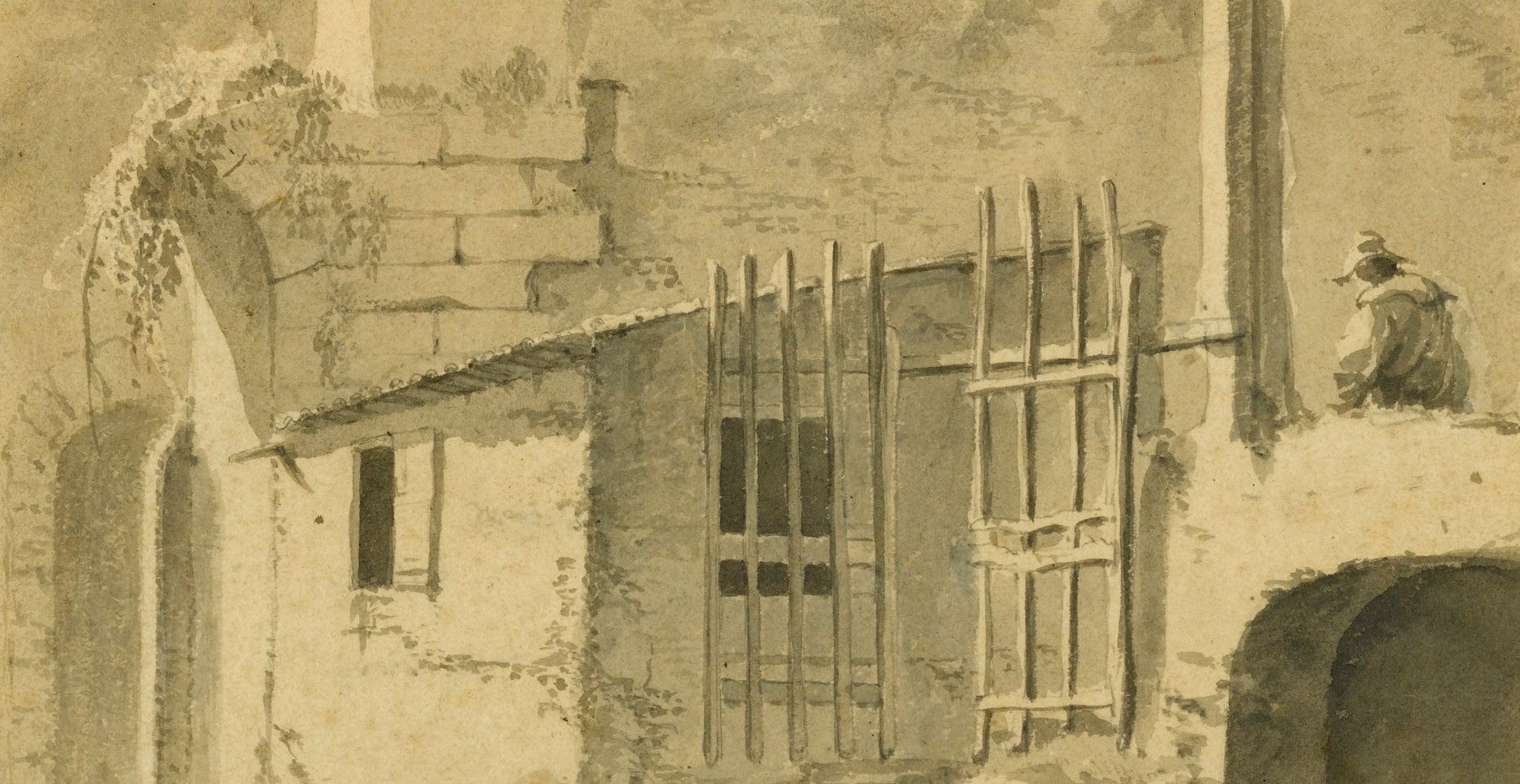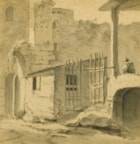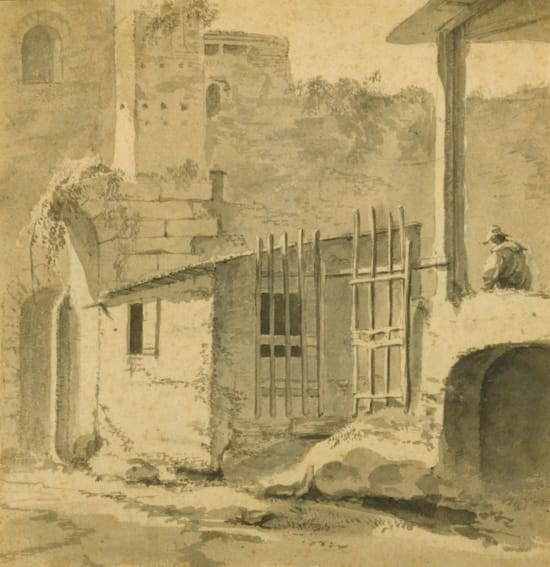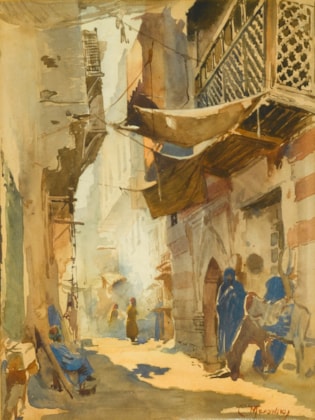homas Wyck
(Beverwijk near Haarlem 1616 - Haarlem 1677)
An Italian Courtyard with a Gateway and Seated Figure
bears various inscriptions in pen and brown ink, verso, mostly illegible, but including the word ‘Pynacker’, and inscription in red chalk: ‘W....m’
brush and gray wash over indications in black chalk
20.8 x 20.1 cm (8⅛ x 7⅞ in)
Thomas Wyck is best known for his depictions of backstreet and courtyard scenes featuring Italianate architecture and picturesque figures. An Italian Courtyard with a Gateway and Seated Figure is highly typical of Wyck’s draughtsmanship, with its expressive line and use of a wash to render the effect of light and shadow. It is similar in style and subject matter to Italian Courtyard with a Well in the Rijksmuseum, which also depicts a typical feature of an enclosed space, desolate except for the solitary figure of a man in one corner. The addition of pen and ink in the Rijksmuseum work gives the image sharper definition but the brown and gray wash conveys the same soft impression of illumination. Wyck, who is known to have lived in Italy, was, like many of his Dutch contemporaries, very much influenced by the warm Mediterranean quality of light he perceived there and the rustic romanticism of the architecture and landscape. He further developed these elements in his paintings and drawings after returning to the Netherlands, often working up his life studies from Rome. His finished paintings, like his sketches, are set apart from those of other Dutch Italianate artists in that they focus on modest architectural views instead of grand Classical or Renaissance monuments. Although they are most likely capriccios, and rarely illustrate an actual site, Wyck’s views of Rome are convincing in their unpretentious subject matter and simple charm.
An Italian Courtyard with a Gateway and Seated Figure like many of Wyck’s compositions is cropped to give the scene greater visual immediacy, with the back wall of the courtyard providing a structure against which to place the other features. The eye is drawn initially to the centre of the image, where a gate stands partially open, one of its doors in shadow and the other bathed in sunlight. To one side of the gate is the corner of a loggia where an artist sketches in the shade, an unusual yet charming inclusion in this work. His figure and clothing are indicated by a few broad sweeps of the brush. On the other side of the gate, a hut with a roof of curved terracotta tiles and square windows with shuttered windows gives the scene a particularly Italian air, as do the heavy stone blocks of the crumbling arch overgrown with foliage and the further arched doorway and window behind.
Wyck’s training most likely took place in Haarlem although the details are not known. His presence in Italy was noted in 1640 by a document stating that a ‘Tommaso fiammingo, pittore’ (Thomas the Fleming, painter) resided in the Via della Fontanella in Rome1. By 1642, he had returned to Haarlem where he was enrolled in the Guild of St. Luke. Wyck’s compositions during his period in Rome show that he was aware of the late works of Andries Both and also those of Pieter van Laer (‘Il Bamboccio’), after whom he structured his characteristic courtyard views. The influence of Jan Asselijn is also very apparent, although Wyck tended to apply his washes in a broader, flatter manner, and was also less theatrical in the way he chose to capture the intense Italian sunlight. Towards the end of his career, Wyck began producing works typical of Dutch genre painting, differing significantly from his Italianate works, although retaining some earlier compositional devices. During the 1660s Wyck travelled to London, where he painted views of the city before the Great Fire of 1666. He was followed there by his son Jan Wyck, who remained in London and greatly contributed to the development of English sporting painting.
1 A. Busiri Vici, ‘Porti, piazzette, casolari di Roma e dintorni di Tomaso G Fiammingo’, L’Urbe, xli/4, 1978, pp. 9-14
Count Gregory Sergeyevitch Strogonoff (L.550);
bears another unidentified collector’s mark (not in Lugt);
Sale, Amsterdam, Christie’s, 14 November 1988, lot 132.
Thomas Wyck is best known for his depictions of backstreet and courtyard scenes featuring Italianate architecture and picturesque figures. An Italian Courtyard with a Gateway and Seated Figure is highly typical of Wyck’s draughtsmanship, with its expressive line and use of a wash to render the effect of light and shadow. It is similar in style and subject matter to Italian Courtyard with a Well in the Rijksmuseum, which also depicts a typical feature of an enclosed space, desolate except for the solitary figure of a man in one corner. The addition of pen and ink in the Rijksmuseum work gives the image sharper definition but the brown and gray wash conveys the same soft impression of illumination. Wyck, who is known to have lived in Italy, was, like many of his Dutch contemporaries, very much influenced by the warm Mediterranean quality of light he perceived there and the rustic romanticism of the architecture and landscape. He further developed these elements in his paintings and drawings after returning to the Netherlands, often working up his life studies from Rome. His finished paintings, like his sketches, are set apart from those of other Dutch Italianate artists in that they focus on modest architectural views instead of grand Classical or Renaissance monuments. Although they are most likely capriccios, and rarely illustrate an actual site, Wyck’s views of Rome are convincing in their unpretentious subject matter and simple charm.
An Italian Courtyard with a Gateway and Seated Figure like many of Wyck’s compositions is cropped to give the scene greater visual immediacy, with the back wall of the courtyard providing a structure against which to place the other features. The eye is drawn initially to the centre of the image, where a gate stands partially open, one of its doors in shadow and the other bathed in sunlight. To one side of the gate is the corner of a loggia where an artist sketches in the shade, an unusual yet charming inclusion in this work. His figure and clothing are indicated by a few broad sweeps of the brush. On the other side of the gate, a hut with a roof of curved terracotta tiles and square windows with shuttered windows gives the scene a particularly Italian air, as do the heavy stone blocks of the crumbling arch overgrown with foliage and the further arched doorway and window behind.
Wyck’s training most likely took place in Haarlem although the details are not known. His presence in Italy was noted in 1640 by a document stating that a ‘Tommaso fiammingo, pittore’ (Thomas the Fleming, painter) resided in the Via della Fontanella in Rome1. By 1642, he had returned to Haarlem where he was enrolled in the Guild of St. Luke. Wyck’s compositions during his period in Rome show that he was aware of the late works of Andries Both and also those of Pieter van Laer (‘Il Bamboccio’), after whom he structured his characteristic courtyard views. The influence of Jan Asselijn is also very apparent, although Wyck tended to apply his washes in a broader, flatter manner, and was also less theatrical in the way he chose to capture the intense Italian sunlight. Towards the end of his career, Wyck began producing works typical of Dutch genre painting, differing significantly from his Italianate works, although retaining some earlier compositional devices. During the 1660s Wyck travelled to London, where he painted views of the city before the Great Fire of 1666. He was followed there by his son Jan Wyck, who remained in London and greatly contributed to the development of English sporting painting.
1 A. Busiri Vici, ‘Porti, piazzette, casolari di Roma e dintorni di Tomaso G Fiammingo’, L’Urbe, xli/4, 1978, pp. 9-14
Count Gregory Sergeyevitch Strogonoff (L.550);
bears another unidentified collector’s mark (not in Lugt);
Sale, Amsterdam, Christie’s, 14 November 1988, lot 132.





 contact
contact contact
contact +44 20 7313 8040
+44 20 7313 8040









